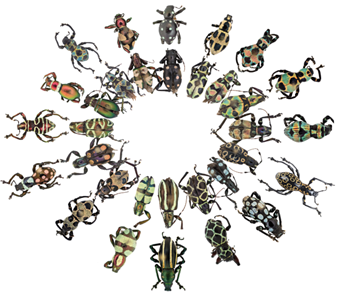Mimicking for Survival—How Beetles Use Color to Outsmart Predators
A new study published in Current Biology not only advances understanding of mimicry systems but also offers new insights into how island biogeography influences species evolution.
Batesian mimicry, where harmless species evolve to resemble harmful species to avoid predation, is a fascinating survival strategy that has long intrigued natural scientists. First described by Alfred Russel Wallace, this evolutionary phenomenon allows species to gain protection by mimicking the warning signals of more dangerous counterparts. In the Philippine archipelagos, the flightless Pachyrhynchus weevils have evolved vibrant warning colors to ward off predators, while the soft-bodied Doliops longhorn beetles have taken advantage of this by mimicking the Pachyrhynchus’s armored appearance.
In a new study published in Current Biology, an interdisciplinary team of researchers of biologists and physicists have uncovered how this mimicry system is shaped more by island geography than by direct coevolution.
Geographical isolation on islands drives evolution
The team, led by scientists from the California Academy of Sciences and the Paris Lodron University of Salzburg (PLUS), used advanced genomic techniques to reconstruct the evolutionary history of Doliops beetles. They found that the mimicry relationships between Doliops and Pachyrhynchus are not the result of strict one-on-one evolutionary tracking but instead emerge from the beetles’ broader environment and the isolation of island ecosystems.
“Batesian mimicry is a striking example of how species interactions fuel biological diversity,” says Dr. Matthew H. Van Dam, lead author of the study. “In the case of Doliops and Pachyrhynchus, geographic isolation on islands plays a key role in shaping how these species evolve.”
The research reveals that Doliops beetles adjust their mimicry based on the local community they encounter, highlighting the flexibility and adaptability of evolutionary processes. “Rather than closely tracking a single species, the Doliops beetles adapt their mimicry based on the community they inhabit,” Dr. Van Dam explains. “This flexibility shows how mimicry can evolve through broader environmental factors.”
Beetle species develop different methods to manipulate light
A remarkable finding from the study was that while both beetle species create their brilliant colors using photonic nanostructures to deter predators, they use entirely different nanoscale mechanisms to do so.
“The photonic structures responsible for these colors are an incredible demonstration of how unrelated species can develop different methods to manipulate light,” says Prof. Bodo D. Wilts from the Paris Lodron University of Salzburg. “While Pachyrhynchus uses diamond-like structures, Doliops relies on opal-like photonic crystals to produce their iridescence.” The team used advanced imaging techniques, to analyze these nanoscale structures, revealing how these adaptations have evolved to enhance survival.
“This diversity in photonic crystal structures highlights evolution’s ability to generate multiple solutions to the same problem,” Prof. Wilts added. “It’s a fascinating case of nature finding different paths to the same optical result – a dazzling display of color.”
______________________________________________________________________
Reference: Van Dam et al., „Biogeography confounds the signal of cospeciation in Batesian mimicry“, Current Biology (2024), https://doi.org/10.1016/j.cub.2024.09.084
Contacts:
MatthecaOl@bvw VanYB2wrs7 Dam,pXVoeS_ PhD |qWikpXV CaliDL8-j0YfornGDL8-j0ia AcademqWikpXVy of SaOl@bv1cien5fPKQFzces 0YB2wrs| DQFzcaOlepartmenv1gGDL8t of EIdmn3hxntomoZMqWikplogy mn3hxtH| mvanpXVoeS_dam@cxtH4Ju.alacaS_N5fPKdemy.o1gGDL8-rgPKQFzca
Univ.-Prof. Dr. Bodo Wilts | Paris Lodron University of Salzburg | Department of Chemistry and Physics of Materials | JaGYPewkob Haewok7ringerzJHB5 StraßygDfTe 2A ewok7| 50T.ViI20 tU_l2SalzB5m3EburgJHB5m | bViIrAodoXvtU_.wi1Lqcslts@hCXvtplus.aPewokc.atGYPew | +fT.Vi43 662-4RuN 804rAK9z4 6202B5m3E





